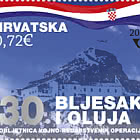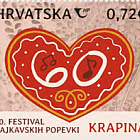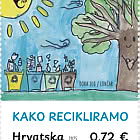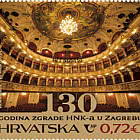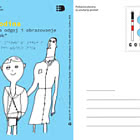Famous Croats
Branko Lustig
On 21 March 1994, the winners of the 66th Academy Awards were announced at the Dorothy Chandler Pavilion in Los Angeles. When it was announced that “Schindler's List” directed by Steven Spielberg won the Oscar for best picture, three winners – the three producers of the movie – took the stage. One of them was a man who survived the Nazi death camps as a young man. His name was Branko Lustig.
Branko Lustig was born in 1932 in Osijek. He became caught up in the war and the genocide of the Jewish people in the NDH when he was nine years old. As a child, he passed through the Auschwitz and Bergen Belsen death camps. His father and most of his family perished in the Holocaust. In the mid-1950s, the ambitious camp survivor entered the newly emerging film industry of SFRY. He started working as a shooting organizer and executive producer. His name appears on credits of a series of important titles of the time, from Branko Bauer's “My Son Don’t Turn Around” (1956 – Lustig's first job), through the Oscar-nominated “The Road a Year Long” (1958), to the historical spectacles “Kozara” (1962) and “Anno Domini 1573” (1975). When in the late 1960s, Jadran Film turned intensively to co-productions with Hollywood, Lustig got involved in these projects. His work on the film “Fiddler on the Roof” (1971) and, especially, on the series “Winds of War” became his ticket to Hollywood. He received an invitation to work in the American film industry, which he accepted permanently in 1988.
In Hollywood, as an executive producer Lustig helped in the creation of a number of notable and popular A-movies. His work is particularly important for two of the most prominent mid-stream directors of that generation: Steven Spielberg and Ridley Scott. Lustig also received two producer Oscars for his work on the movies by these two directors: In 1994 for “Schindler's List” and in February 2001 for the “Gladiator”. Lustig thus became the only person from Croatia to win the world's most prestigious film award twice.
Towards the end of his life, he permanently returned to Zagreb, where he was also active as the founder of a film festival. He passed away in 2019.
Jurica Pavičić, writer,
columnist and film critic
Miljenko Smoje
There are few writers in Croatian culture who can be said to have created their own native land. One of them is without doubt Miljenko Smoje, a journalist, screenwriter and novelist from Split. In his writing, Smoje did not only describe central Dalmatia; he created it: he constructed its media image, created its mythology, immortalized its mentality, codified its language. If there is a repository of ideas, sounds and faces of Dalmatia that is permanently imprinted on both Croatian and (ex)Yugoslav audiences, a significant part of that repository is precisely the work of Miljenko Smoje.
Miljenko Smoje was born in 1923 in Veli Varoš, Split, to a fishing family. After a short teaching career, he joined “Slobodna Dalmacija” as a journalist. He quickly established himself as a gifted reporter with a lively language, insightful observations and witty style. He traveled through Dalmatia, wrote reports and humorous stories. With his reporting work, he reaffirmed the Central Dalmatian Chakavian and returned its rightful place in the media. By the mid-1960s, he was already a popular and well-read local journalistic star. In 1971, he published his first book, “The Legend of Hajduk” created on the occasion of the 60th anniversary of the football club from Split. This touching and humorous chronicle has gone beyond its occasional function and serves as a novelistic chronicle of Split.
Smoje achieved the greatest fame through the new medium of television. In 1970, Zagreb TV produced the TV series “Naše malo misto” (Our Little Town) – a chronicle of a fictional town in central Dalmatia from the 1930s to the 1960s. The series gained enormous popularity and the status of a classic with regular reruns. Smoje managed to novelize the series in an eponymous novel. In 1980, Smoje once again wrote a more expensive, more ambitious series “Velo misto” (The Big Town) for Zagreb TV, which follows the history of Split and the football club Hajduk from 1910 to 1945. Smoje novelized this series as well, and the resulting novel is often held in higher regard than the series.
In the following period, Smoje worked constantly as a stage writer and screenwriter for films and TV dramas. However, he never stopped being a journalist. Until his death, he published columns, reports and humorous stories in “Slobodna Dalmacija”, and then in the “Feral Tribune”. He died in 1995 at the age of 72 from cancer, and his last text – published only a few days before his death – ended with the word “write”.
Jurica Pavičić, writer,
columnist and film critic
Dušan Vukotić
In no area of film culture has Croatian cinematography left such a globally visible mark as it did in animated film. This can primarily be attributed to the production of the Zagreb Film studio from the mid-1950s to the 1970s, a group of authors and films commonly called the “Zagreb School of Animated Films”. And the most famous among them is undoubtedly Dušan Vukotić, the director who won an Oscar for “The Substitute” in 1961. Vukotić is also the only author of Croatian films to win an American Academy Award.
Dušan Vukotić was born in 1927 in Bileća (Bosnia and Herzegovina). Like many future directors of the Zagreb School, Vukotić also studied architecture. Furthermore, like a number of Zagreb animators, he honed his first creative experiences in the medium of caricature. Since the beginning of the 1950s, he had been active in animation, first as an animator, then as a director of dedicated films, and from the 1950s also of original films. Immediately after the foundation of the new studio in 1956, he created his first directorial work, “Naughty Robot”.
From that moment, a handful of creative people – directors, animators and cartoonists – gathered around the newly created studio, and tried to pave their way into animated film. They realized that they had neither the resources nor the experience to compete with Disney in full, illusionistic animation. Instead, they began to explore reduced animation with simplified surfaces, stylized movement and an emphasis on gags. In doing so, they relied on the experiences of caricature, but also on the strong visual culture of the 1950s Zagreb, especially on EXAT 51. Thematically, the authors of the Zagreb School are the children of the then non-bloc and politically ambitious Yugoslavia. In the films, they question militarism, global weaponization, but also the side effects of modernization and urbanization. Their topics were global, as was their reception. As early as 1958, eight films from Zagreb were shown in the Cannes program, and prominent French film critic Georges Sadoul gave the group of authors a name that will remain: “L'École du Zagreb”.
Among them, Vukotić was the most successful, but also the most typical representative. In his first films, he plays with the convention of Western genres and parodies it (“Cowboy Jimmy”, 1957, “Machine Gun Concert”, 1958, “Cow on the Moon”, 1959). His most mature phase followed from the late 1950s to the early 1960s, when he shot his three arguably most famous films: “Piccolo” (1959), “The Substitute” (1961) and “The Game” (1962), with “The Substitute” remaining the most famous one primarily because it won the American Academy Award, making Vukotić the first non-American to win an Oscar for an animated film. “The Substitute” is in many ways a typical Vukotić: a film about the absurdities of modernization created with an original, almost abstract visual style that effectively uses proportions, whiteness and an empty frame.
Vukotić continued to successfully engage in animated films until the 1970s. He gradually tried his hand as a director of full-length feature films, but not nearly as successfully. He shot the feature films “The Seventh Continent” (1966), the urban war thriller “Operation Stadium” (1981) and the sci-fi film “Visitors from the Arkana Galaxy” (1981). He died in Zagreb in 1998 at the age of 71.
Jurica Pavičić, writer,
columnist and film critic
Juro Tkalčić
In the history of Croatian musical interpretation, the cello does not have a large number of distinguished artists, especially not those with an international career. Among this small number of musicians, Juro Tkalčić (Zagreb, 13 February 1877–Zagreb, 15 December 1957) is regarded a kind of founder, who after primary education in Zagreb and later in Vienna, went to Paris, where he started playing in various orchestral and chamber ensembles while continuing his additional education, but also performed as a soloist with his brother, pianist Ivo Tkalčić (1875–1937). His reputation was gradually growing, so as a member of chamber and orchestra ensembles, he took part in tours throughout Europe. In 1900, he settled in Paris. At first he played in café orchestras, but soon became one of the most prominent chamber musicians in Paris and played in prominent chamber ensembles performing in Paris and other French cities. In 1904, he started teaching at the Conservatory in Versailles. In 1914, he returned to Zagreb, where he performed as a soloist and chamber musician, and was employed as a professor at the conservatory. With the founding of the Royal Academy of Music in 1922, he continued his career as a professor at that higher education institution and became its first rector already during the first year. He later worked in Belgrade, then in Dubrovnik before finally returning to Zagreb.
Writing about his performances, critics of the time emphasized the exceptional virtuosity and beauty of his tone. His compositional oeuvre belongs to the late-romantic concept of music, the miniatures mostly have a salon character. However, it is important to point out that Tkalčić is the author of the first Croatian concerto for cello and orchestra, and the works for chamber ensembles are more ambitiously composed.
Tkalčić died in 1957. At that time, Antonio Janigro was already living and working in Zagreb, and soon Marijan Jerbić would also make his debut. A few years later, the star of Valter Dešpalj and then Monika Leskovar will shine. One might conclude that Tkalčić plowed an artistic furrow that continues today.
Erika Krpan, musicologist and
member of the Croatian Composers'
Society
Croatia - Recommended stamp issues
WOPA+ recommended stamp issues
| Avatar - Fire and Ash |
| Issued: 03.12.2025 |
| ›New Zealand |
| 50th Anniversary of the Founding of the 24th November Bar Scout |
| Issued: 24.11.2025 |
| ›Montenegro |
| Krisjanis Valdemars |
| Issued: 02.12.2025 |
| ›Latvia |
| Sign Language - Good |
| Issued: 02.12.2025 |
| ›Bosnia and Herzegovina - Republic of Srpska |
| In Memory of the Fallen and Murdered on October 7, 2023 |
| Issued: 08.10.2025 |
| ›Israel |
| Annual Collection Folder (New York) |
| Issued: 05.12.2025 |
| ›United Nations |
| Year Set |
| Issued: 24.11.2025 |
| ›Isle of Man |
| Shipping in the 17th and 18th Centuries - Peat Shipping |
| Issued: 05.12.2025 |
| ›Netherlands |









